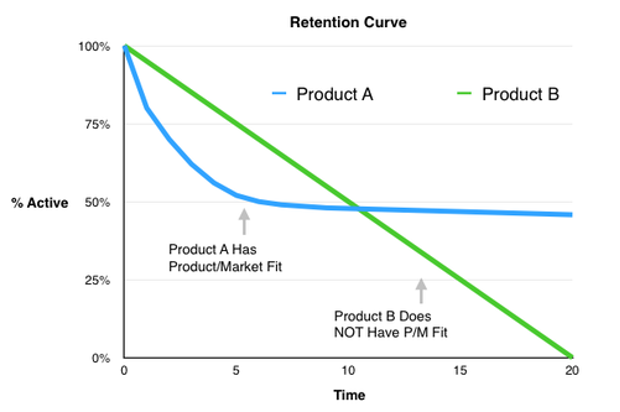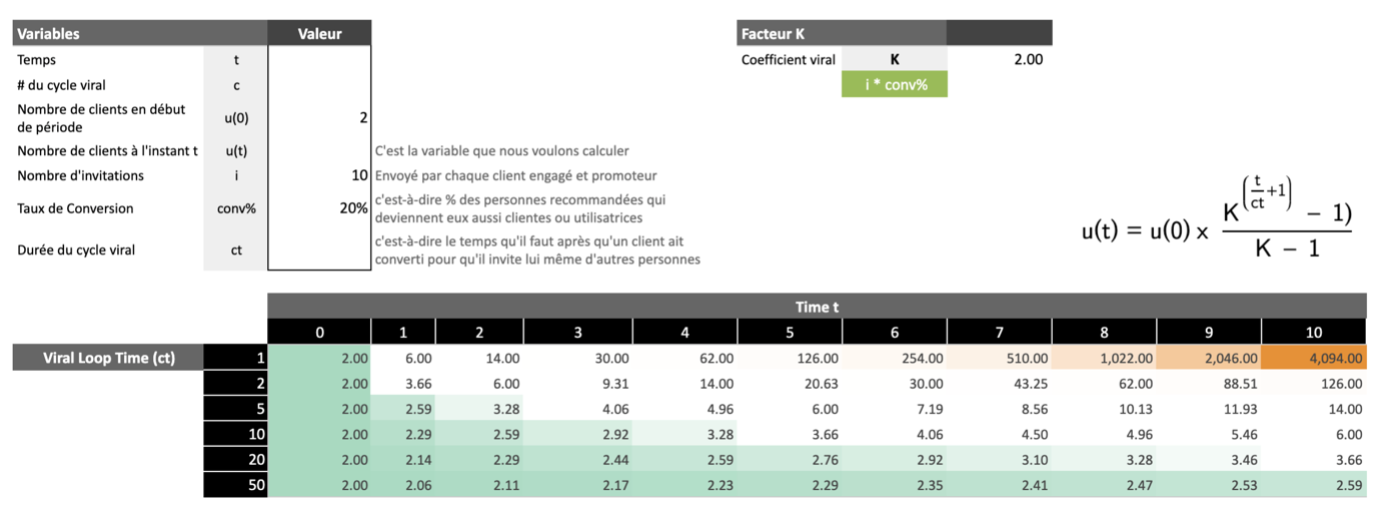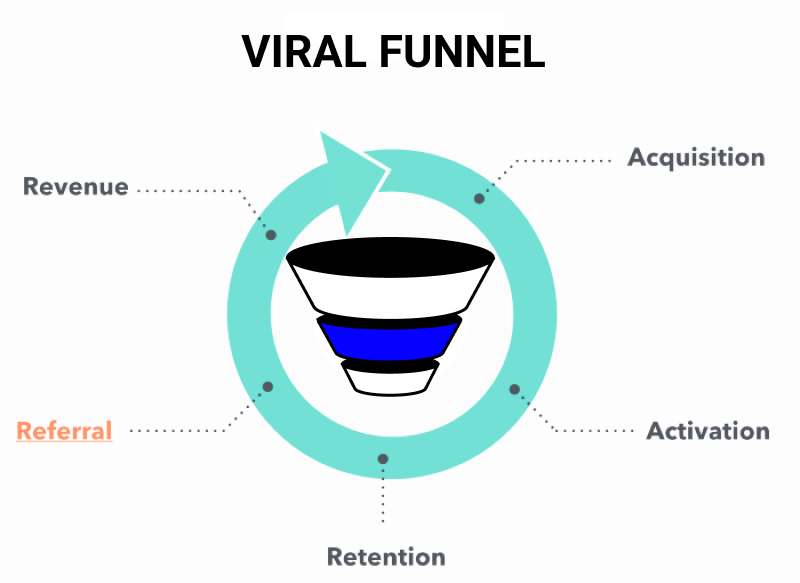Viral loops reduce customer acquisition costs. Learn how the K factor and viral cycles contribute to growth and encourage customers to promote your brand.
The K-factor can be used to describe the growth rate of websites, applications, or a customer base... This use is borrowed from the rate of reproduction in the field of epidemiological medicine.
A virus with a K factor of 1 is in a “stable” state: this means no growth or decline. A K-factor greater than 1 indicates exponential growth and a K-factor of less than 1 indicates exponential decline.
.png)
There are forecasted growth indicators and indicators based on past events. Customer acquisition cost (CAC), retention, and monthly active users (MAU) are performance indicators based on past events that we look to to assess our success.
The K-factor is different, we can use it to understand the future effect and the trend of growth loops. Let's look at its formula and calculation method.
The K factor is an organic and free acquisition driver that is fuelled either by the growth characteristics of your product or service, or by enthusiasm for your business. If you master both at the same time, you can have the chance to reach very good levels of success and virality.
To understand the K-factor, what we're trying to determine is this: For each customer you acquire, how many new customers will they bring you?
Here is the formula:

Let's take an example now to put this formula into practice.
Here is an example of how to calculate your viral K-factor or coefficient:
If each new customer invites two more people, the snowball starts. In reality, a K factor greater than 1.0 is very rare and not sustainable. However, a K-factor of less than 1.0 can still be very powerful, so don't dismiss it as not being “viral enough.”
The following are the types of behavior based on the K-factor value:
The K-factor generally decreases as the business develops, making it possible to reach a larger audience with lower network density. Advertising and word of mouth are easier to generate with a small audience grouped around certain sectors, interests or values.

A high K-factor allows you to spend more money on any form of acquisition.
The K-factor acts as an accelerator, giving impetus to all other acquisition channels and optimizing them. Indeed, the more customers you acquire by organic methods, the lower your overall CAC (Customer Acquisition Cost) will be.
The real problem with this statement is that it doesn't talk at all about the factors that actually determine Product Market Fit.
A Product Market Fit (PMF) means that you have a market (that is, a group of people who have a pain or a need) and that your product or service provides solutions to it.
The k factor is an insufficient condition and explains the PMF, but it is somewhat related. In the best case scenario, you calculated k using correct assumptions. You see customers who stick with and stay on your product or service. They invite new prospects to test and realize the value of what you offer. If all of these things are true, then you have a product or service that provides real value and has the potential to go viral.
But again, the determining factor of the PMF is in fact the retention rate.

For example, some apps literally pay their customers to send recommendations. In case you notice a lot of recommendations that have converted and come from this type of system, that just proves that there is a market of people who want to be paid for it. All of this has nothing to do with the actual product or service and how it responds to it.
If you take this formula at face value, you are only measuring the effectiveness of your referral program, not your virality.
Virality depends on many other factors that we are going to see in the virality loops formula.
That's good, we'll see that right away.
Now that we've reviewed some fundamental elements, let me give you the most basic equation that will allow you to project the impact of virality over a fixed period of time.
This may seem complex at first glance. But if you take a few minutes to figure things out and translate the formula I'm about to give you into a spreadsheet for more practical use, you'll make your life easier as we continue our exploration of virality loops.
Let's start by defining a few variables. Some that you already know, others that we haven't used yet:

It may seem a bit complex at first, but you don't need to memorize this formula. All you need to do is put it into practice in a spreadsheet so that you can simply add the values of your variables measured by your analysis tools.
Download this sample online sheet to find the methods for calculating the K factor and virality loops
Don't worry I've prepared an example for you to download for free above.
Below is the influence of the ct variable - time of virality cycles - that you can find in this Spreadsheet.

As you can see, the influence of ct is potentially even greater than that of K itself, contrary to what all articles on the Web may report. We are going to see right now how to maximize our virality.
It's important to keep in mind something we've just talked about:
Using the values from our previous example, here is a graph showing the influence of the value of ct on virality.

As seen together, the shorter the duration of growth cycles and the greater the virality, this is what we are now going to see through a very well known example: that of Youtube.
When the viral cycle length is shorter, growth becomes more rapid.
That's why YouTube has exploded faster than any other business we've ever seen before. They wanted to create a service that allowed users to easily stream and share video without having to worry about downloading or sending files. They have therefore integrated virality at the very heart of their strategy. (If you want to know exactly how YouTube did it, I'll go deeper into that in a previous chapter.)

This is how YouTube built its product in such a way that the duration of its cycle is just over 2 minutes on average. Users thus had the “mathematical” ability to perform more than 650 viral loops in a single day.
While not realistic for a single user, with each viral loop completed, more and more people were exposed to the product and sent out their own invitations.
Confusion can sometimes occur when talking about virality because people often use the term “viral loop” to refer to viral marketing. But what is the difference?
Both techniques aim to promote sharing, but a viral loop is more focused on customer acquisition, while viral marketing aims to increase brand awareness.

While viral marketing is less predictable, anyone can create a viral loop if they follow the right methods. Let's take a closer look at it.
Although all viral loops have the same structure, you need to decide what type of virus loop you want to create and how you are going to motivate your customers to recommend you. Here are a few examples:
When building your viral loop, it's best to make sure you have a well-thought-out funnel and recommendation system in place before you start running and optimizing your campaign.
Here are a few things to remember:
If you're not sure where to start or what KPIs to analyze in your analyses, I recommend taking a look at your Pirate Funnel. (The Viral Funnel shown below is a “cyclical” Pirate Funnel)

The metrics in your funnel will be a good way to optimize all stages of the Pirate Funnel (AAARRR) in order to optimize your growth and the power of your viral loop.
There are a lot of things to consider when analyzing your viral loop.
The two main benefits of creating viral loops are that they are cost-effective and that they work through trust.
When your customers share your brand with others, it's free advertising.
When done right, the results are almost magical. One user becomes two, then four, then eight - you get the point. All of this without spending a cent, aside from your initial investment.
On average, 92% of people trust recommendations from their bets more than information sent directly by businesses.
Virus loops focus on optimizing this process to make sharing as easy and accessible as possible. Essentially, it's about turning new customers into trusted salespeople.
If your product has a low retention rate, you should first focus on increasing user retention and adapting the product to the market. It's harmful and a waste of time to achieve viral growth when the same users unsubscribe after signing up. Once users leave, they may never return. An engaging product where users sign up and stay is the basis for a successful viral growth campaign.
Marketing tactics often work at first and then stop. Marketers are always jumping at the chance to replicate effective tactics. The response rate falls when consumers get tired of these tactics. To be successful, you need to have an idea of what motivates your customers to share and prospects to join. Offer your users personalized and adapted incentives to encourage their sharing.
The virus loop fails when the process is too confusing or complicated. Seek clarity and simplicity. A tweet can go viral because retweeting is easy and immediate. Create an experimental framework to test and improve the viral loop. Strive to achieve the following goals: